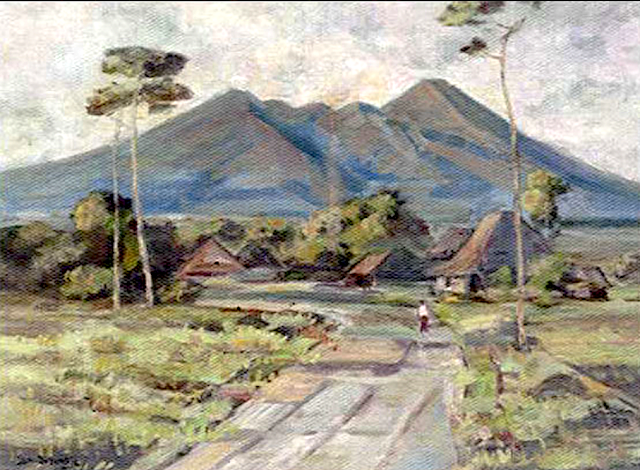PAUL CÉZANNE (1839-1906)
Montagne Sainte-Victoire (1, 011m - 2, 216 ft)
France (Provences-Alpes-Côte d'Azur)
In La Montagne Sainte-Victoire, c. 1900. watercolor and graphite on wove paper,
Barnes Foundation
Barnes Foundation
The mountain
Mont Sainte-Victoire (1,011 m-3,316ft) also called Mont Venturi is a limestone massif in the South of France, in the region Provence-Alpes-Côte d'Azur. Located east of Aix-en-Provence, it has experienced international fame, due to the more than 80 works Paul Cézanne did on it. It hosts many hikers, climbers and nature lovers, and is a major element of Aix landscape.
The range of the Sainte-Victoire is located on the Bouches-du-Rhône and Var, and in the towns of Puyloubier, Saint-Antonin-sur-Bayon, Rousset, Châteauneuf-le-Rouge, Beaurecueil, Le Tholonet Vauvenargues, Saint-Marc-Jaumegarde, Pourrières, Artigues and Rians. On the northern side, the D10 crosses the Col de Claps (530 m) and the Col des Portes (631 m). On the southern side, the D 17 walks on the Plateau de Cengle and crossed the Collet blanc de Subéroque (505 m).
The massif rises to the Pic des Mouches (Peak of the Flies) (1,011 m) near the eastern end of the chain, and not at the Croix de Provence (946 m) near the west end and visible from Aix. The Pic des Mouches is one of the highest peaks of the department of Bouches-du-Rhône, behind the peak Bertagne which reached an altitude of 1,042 mètres and which is located on the massif of Sainte-Baume.
Sainte-Victoire, as the range of the Sainte Baume, can be considered a special case among the Alpine ranges for the various stages of the formation of its relief associated geological history as well as that of the old Pyrenean-Provençal chain than that of the Western Alps (which have succeeded it).
Indeed, from the former Sainte-Victoire mountain, contemporary of the dinosaurs of the Cretaceous, appeared 15 million years BCE.
Sainte-Victoire, whose calcareous sediments date back to the Jurassic, thus consists of both a Pyrenean-Provencal vestige and of an alpine geology.
The massif is a ensemble of 6525 ha classified since 1983.
The massive hosts several world-famous dinosaur eggs deposits including the Roques-Hautes / Les Grands-Creux on the town Beaurecueil.
The painter
The mount Sainte-Victoire appears to have been the subject of a true love story with the painter (Paul Cézanne). He painted this subject more than 80 times, in oil paintings, watercolors and drawings !
Aix-en Provence (France) painter Paul Cezanne still remains closely linked to his hometown. His studio in Les Lauves remains a place to visit, as if the painter was coming back from one second to the other. But the eternal bond is undoubtedly the series of paintings he did of the Montagne Sainte-Victoire. A hobby, a passion, a thread in the painter's work that took place in the latter part of his life, between 1882 and 1906 when he died in Aix. History says that the painter had contracted a nasty pneumonia during a working session on the mountain. This is what can be called 'die on stage'.
Cézanne had a considerable influence on the art of the late nineteenth and the early twentieth century. Acknowledged master of his time, he attended during stays in Paris between 1862 and 1882, the Impressionist band: Camille Pissarro, Auguste Renoir (who also ended his life in the Provencal brightness), Claude Monet, Alfred Sisley and others. He participated in the Impressionist adventure while keeping his personality: it is the time of the shock of the en plein air, easels in the grass, looking for natural light and emotion.
The influence of the Aix painter is recognized in the history of art since it would be the cause of the Cubist movement embodied in 1906 by Pablo Picasso and Georges Braque. The first historically so called Cubist painting ' Les Demoiselles d'Avignon' would, a true artistic shock shown by Picasso in 1907 (one year after the death of Cézanne) is today one of the masterpieces of the MoMA in New York.
It is the search of volumes around which leads to the appearance of geometry in landscapes or still lifes of Cézanne.In 20 years, Cézanne pushes his style to express the emotion of the landscape, suggesting the wind, involving movement just like if we can breathe the air of the scene. In his first paintings pf the Sainte Victoire,(in the 1880’s) he expresses the giant aspect of the mountain that dominates the area with his characteristic e way of painting at the time, with a juxtaposition of linear brushstrokes and a range of soft, natural colors. IN the last paintings of the Sainte Victoire, view from Les Lauves, between 1904 and 1906, he shows shots less accurate brushes allowing the shape of the mountain emerge from the canvas like an apparition. That is the whole intention of the artist, show nature as it is without fail to convey emotion.
A true love story…
2018 - Wandering Vertexes...
by Francis Rousseau
2018 - Wandering Vertexes...
by Francis Rousseau




















